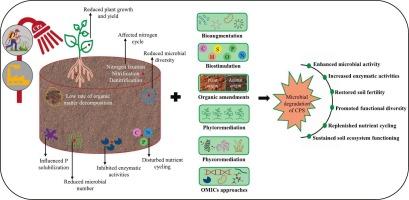氯酚对微生物活性和功能多样性的影响:组学方法和土壤微生物修复的最新进展
IF 5
2区 农林科学
Q1 SOIL SCIENCE
引用次数: 0
摘要
氯酚是一种有毒的有机污染物,通过施用农药和工业废水释放到环境中,对生物体构成严重的健康风险。暴露于CPs会对土壤微生物群落和功能多样性产生不利影响,导致土壤退化和污染。基于毒性、环境持久性和潜在的生物积累,CPs污染是一个全球关注的问题,必须迅速解决,以防止其对土壤生态系统功能和其他生物(包括人类)产生不可避免的影响。土壤微生物种群在高cp浓度下迁移或消失,显著干扰了微生物多样性及其功能。此外,CPs可以破坏土壤微生物的细胞膜,减少它们的数量、生长和酶活性。此外,CPs污染会影响养分循环过程,降低各自微生物酶的活性,影响微生物和植物的养分有效性。此外,某些本地和生物增强的微生物菌株已显示出显著的潜力(高达100%),可降解CPs的好氧和厌氧,以减轻其对土壤微生物群落的毒性作用。基于omics的方法还可以通过调节基因表达来提高降解效率,从而开发耐药微生物菌株、代谢物、蛋白质、基因和cps降解酶。CPs可以通过间裂解和正切裂解降解,由特定的酶如单加氧酶和双加氧酶催化,使用对苯二酚或4-氯儿茶酚降解途径。此外,结合不同的修复方法,如生物增强、生物刺激、有机修正、藻修复和植物修复,可以显著提高土壤中CPs的降解。因此,与其他生物修复方法相结合,微生物修复有可能用于处理cps污染的土壤并恢复生态系统功能。本文章由计算机程序翻译,如有差异,请以英文原文为准。

Effects of chlorophenols on microbial activity and functional diversity: Recent advances in OMICs approaches and soil microbial remediation
Chlorophenols (CPs) are toxic organic contaminants released into the environment through pesticide applications and industrial effluents, posing serious health risks to living organisms. Exposure to CPs can adversely affect the soil microbial community and functional diversity, leading to soil deterioration and contamination. Based on toxicity, environmental persistence, and potential for bioaccumulation, CPs contamination is a global concern that must be addressed promptly to prevent its inevitable effects on soil ecosystem functioning and other living organisms, including humans. The soil microbial population shifts or disappears under higher concentrations of CPs, significantly disturbing microbial diversity and their functions. Further, CPs can disrupt the cell membrane of soil microbes, reducing their number, growth, and enzymatic activities. Furthermore, CPs contamination can impact nutrient cycling processes and reduce the activities of respective microbial enzymes, affecting nutrient availability for microbes and plants. Moreover, certain indigenous and bioaugmented microbial strains have demonstrated significant potential (up to 100 %) for the aerobic and anaerobic degradation of CPs to alleviate their toxic effects on soil microbial communities. OMICs-based approaches can also be applied to develop resistant microbial strains, metabolites, proteins, genes, and CPs-degrading enzymes by regulating their gene expressions with enhanced degradation efficiencies. CPs can be degraded by meta- and ortho-cleavage, catalyzed by specific enzymes such as monooxygenase and dioxygenase, using either hydroquinone or 4-chlorocatechol degradation pathways. In addition, integrating different remediation approaches such as bioaugmentation, biostimulation, organic amendments, phycoremediation, and phytoremediation can significantly enhance CPs degradation in the soil. Thus, in conjunction with other bioremediation approaches, microbial remediation could potentially be deployed to treat CPs-contaminated soils and restore ecosystem functioning.
求助全文
通过发布文献求助,成功后即可免费获取论文全文。
去求助
来源期刊

Applied Soil Ecology
农林科学-土壤科学
CiteScore
9.70
自引率
4.20%
发文量
363
审稿时长
5.3 months
期刊介绍:
Applied Soil Ecology addresses the role of soil organisms and their interactions in relation to: sustainability and productivity, nutrient cycling and other soil processes, the maintenance of soil functions, the impact of human activities on soil ecosystems and bio(techno)logical control of soil-inhabiting pests, diseases and weeds.
 求助内容:
求助内容: 应助结果提醒方式:
应助结果提醒方式:


